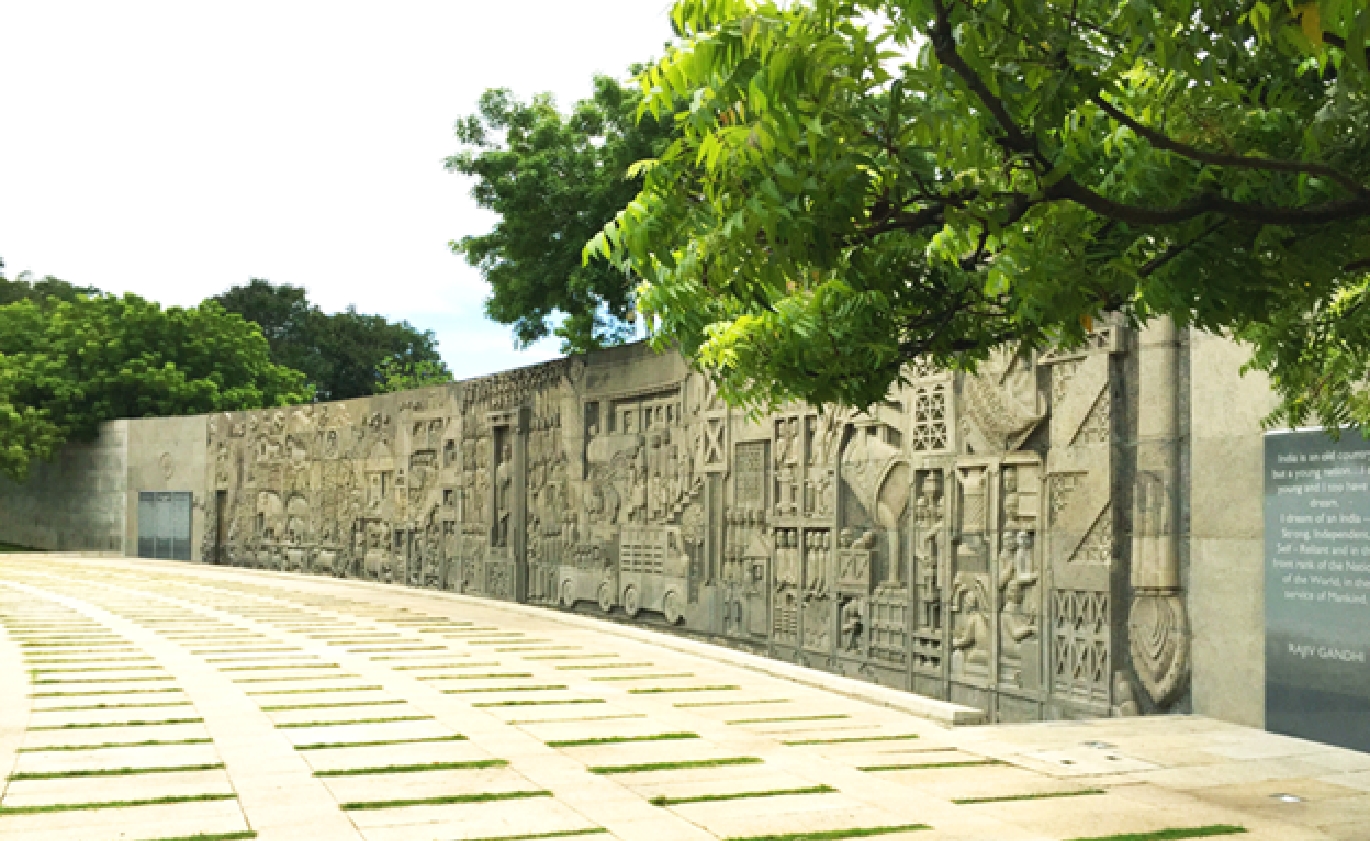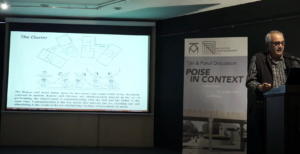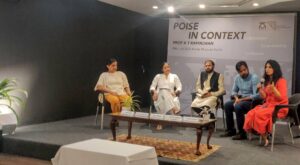 Whats New: Check EVENTS to sign up for art workshops, Janal Talks, Film Screenings & More!
Whats New: Check EVENTS to sign up for art workshops, Janal Talks, Film Screenings & More!  Whats New: Check EVENTS to sign up for art workshops, Janal Talks, Film Screenings & More!
Whats New: Check EVENTS to sign up for art workshops, Janal Talks, Film Screenings & More! 
On 24th July 2022, the Kerala Museum in collaboration with the Institute of Urban Designers, India, hosted a talk by eminent architect, urban designer, academician and author Prof. K.T Ravindran.
The talk titled Poise In Context – Collaboration, Co-production, Confluence, was preceded by addresses from Dr. Venu. V, IAS Home Secretary of Kerala State, Ar. Biley Menon, Vice President of IUDI and the Kerala Museum Director Aditi Nayar Zacharias.
The Kerala Museum is a distinguished platform for the arts in Kochi, that bolsters trans-disciplinary dialogue endorsing itself as an active dais for Kochi-ites to engage with art and culture. In this changing society, the museum’s new roles include extending social connections with the city of Kochi and its people and encouraging diverse discourses.
‘Poise in context – Collaboration, Co-production, Confluence’, his signature talk, is a reflection of the ethos of Prof. Ravindran’s Delhi-based architecture and urban design practice. In a 1994 retrospective article of the same name for the Architecture plus Design magazine, he wrote “architecture offers us the freedom to feel the pain of the earth as we stab the ground with our pencil”. This resonates KT’s sensibilities as an architect-urban designer and ideology of his practice, which he distinguishes as a ‘value-based practice’. He has served as the Dean and Former Head of Urban Design at the School of Planning and Architecture, Delhi, founder President of the Institute of Urban Designers India and Dean Emeritus of Royal Institute of Chartered Surveyors (RICS) School of Built Environment, Noida. Recently, he was one of the five members picked from across the globe to become an Advisor to the Secretary of the United Nations, aiding in the preparation of the UN Capital Master Plan for New York. Originally from Thallassery, he began his architectural career in the 1960s at the age of 21, after completing his bachelor’s degree from the AC College of Technology in Chennai. He went on to complete a postgraduate degree in Urban Design from Delhi in the 1970s. He has since emerged as a resilient force within the Urban Design industry.

Fig: Along the bas relief at the Rajiv Gandhi Ninaivakam, Pic Credit: KTR Studios
Prof. K.T Ravindran shared the stories of three projects from his illustrious career spanning five decades. His body of work, ranging from policy to praxis, spans across the Indian sub-continent from Srinagar in the North, Lakshadweep in the West, Guwahati in the East and Trivandrum in the South. His contribution to the built environment is a product of an urban consciousness not unlike his contemporary Charles Correa, with whom he had a long-standing association from their time working together at the Delhi Urban Arts Commission. While later serving as the chairman of the commission, Ravindran was instrumental in enmeshing heritage conservation with socio-economic development and community involvement, for example, in the Hazrat Nizamuddin area. Closer to home, he fashioned the Heritage Zone demarcations for Fort Kochi and Mattancherry for INTACH all the way back in 1986, the first-of-its-kind in India. Later in 2013, he was also part of a team of national and international experts who prepared the UNESCO aided Fort Kochi-Mattancherry Heritage Zone Conservation Management Plan.

Fig: Dance, Movement and Architecture – Spatial Articulation of the Multi-cultural centre in Rewa, MP. – A still from the presentation. Source: MN Foundation Youtube Channel
Choosing not to build when not needed to, the architect notably opined throughout the course of the talk that “an existing building is the most sustainable building.” The three unique projects discussed- The Jawahar Nehru Junior College – a residential school in Kadmat, Lakshadweep, The Rajiv Gandhi Ninaivakam – a Memorial for Rajiv Gandhi in Sriperumbudur and The Banabhatta Antarbharathi Sanskriti Kendra- a Multidimensional Cultural center in Rewa, Madhya Pradesh, set the tone for his architectural practice, wherein each project is curated with utmost care. By enmeshing the geo-political scenarios into the architectural tectonics, Prof. Ravindran manages to politicize his architecture. For instance, by choosing to leave the ground unbuilt in the Memorial, he harnesses the power of the land that soaked-in Rajiv Gandhi’s death, transcribing it into the columnar space through layered symbolisms.
It was Prof. Ravindran himself who incited the question for the subsequent panel discussion on the notion “is Modernism dead?”. His outspoken and opinionated voice has even earned him the sobriquet of ‘Militant Architect’, though he is endearingly called K.T by his contemporaries, colleagues and students. His unique take on architecture and urbanism makes one believe that architectural production is about cultivating the right people – whether it be the Tamil artisans who hand-carved the relief wall at the Rajiv Gandhi Memorial in Sriperumbudur or the workers belonging to an ancient tribe of ship loaders from Kerala, who hoisted the heavy capitals on to its seven pillars. It was heart-warming to see an individual who has served in many dominant positions throughout his career not only acknowledge the contributions of his team but elevate them to co-producers of space. It is also a rarity to see an architect work with such ease with the PWD and CPWD, even moulding their working method towards the fulfilment of the design intents of the projects. While he brushes this off as a perk of being an ‘architect from Delhi’, it is clear that the work ethic and charisma of the architect contributed significantly to these smooth liaisons. As a gifted story-teller, he captivated the students and architects in attendance, punctuating his talk with a multitude of teachable moments. With an innate ability to hold discourses on topics ranging from sustainability, economic development, climate change, urban morphology to heritage conservation, he uses his vast knowledge to realise rich and layered projects.

Fig: A still from the panel discussion. From left to right: Kunjan Gard, Sandhya Kurshingal, Aabid Raheem, Thomas Ommen & Anubha George
The talk was followed by a fiery and insightful panel discussion on the notion, “is modernism dead?”. The panel was composed of four distinguished panellists from academic, theoretical and design backgrounds – Kunjan Garg, Aabid Raheem, Thomas Oommen and Sandhya Kurushingal and was moderated by Anubha George, a former BBC editor currently based in Kochi. Kunjan Garg is an architect-academician and co-founder of the firm RGB Studio, and currently the Foundation Studio Lead at SEED School of Environmental Design. Aabid Raheem is an award-winning architect and the co-founder, principal architect and urban spatial analyst at [ar&de]. Thomas Oommen is an architect, urbanist and PhD candidate in architectural history, theory and society at the University of California, Berkeley. Sandhya Kurishingal is the creative head and founder of Graycell Design, print and digital communication design studio. From the datedness of the ‘ism’, the distinction between modernisation, modernity and modernism, contradictions to original modernistic ideology and the emergence of a functional mode of thinking, the intellectual discourse offered many thought-provoking perspectives to ruminate on.
References:
Get exciting updates about our events and more